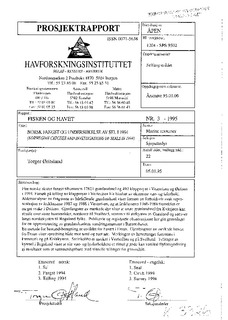| dc.description.abstract | Four Norwegian vessels caught a total of 17621 harp and 492 hooded seals in the West Ice
(Greenland Sea) and the East Ice (Barents Sea) in 1994.
The Norwegian Marine Mamma1 Research Programme was brought to an end in an 'International
Symposium on the Biology of Marine Mammals in the Northeast Atlantic' in 1994. Presentations
involving studies of seals included assessments, biology, physiology, ecology, energetics,
parasites, contaminants and interactions with fisheries.
An attempt to survey hooded seals in the West Ice was impeded by extremely unfavourable
weather- and ice-conditions. Age compositions from catches of moulting harp seals indicate a
continued relatively poor representaion of year-classes 1987 and 1988 in the West Ice and a very
poor representation of the year-classes 1986, 1987 and 1988 in the East Ice. Recaptured of
tagged seals show that subadult harp seals from the White Sea may disperse over wide areas of
the Northeast Atlantic, to Svalbard in the north, East-Greenland in the west and the North Sea
coast of Rogaland County in the south. Published and recorded observations have been used as
basis for a review of harp seal migration patterns in the Barents Sea through the year.
A method has been developed for assessment of grey sea1 pup production at Froan in South-
Trøndelag. Recaptures of grey seals tagged at Froan show a fairly wide dispersal along the coast,
both northwards and to the south. Taggings of grey sea1 pups were continued in Finnmark
County and in support of a Russian programme on the coast of the Kola Peninsula. Common
seals were tagged at Vesterålen in Nordland County and at Svalbard. Experimental off-season
surveys in Rogaland indicate that vertical aerial photography may provide results which are
comparable to visual surveys from motorized dinghies. NORSK SAMMENDRAG:Fire norske skuter fanget tilsammen 17621 grønlandssel og 492 klappmyss i Vesterisen og
Østisen i 1994.
NFRs sjøpattedyrprogram ble avsluttet med et internasjonalt symposium i 1994. Rapporter om
undersøkelser av sel omfatter b1.a. bestandsforhold, biologi, fysiologi, økologi, energetikk,
parasitter, forurensning og interaksjoner med fisket.
Forsøk på telling av klappmyss i Vesterisen ble hindret av ekstreme vær- og isforhold. Aldersanalyser
av fangstene av hårfellende grønlandssel viser fortsatt en forholdsvis svak representasjon
av årsklassene 1987 og 1988 i Vesterisen, og at årsklassene 1986- 1988 fremdeles er meget
svake i Østisen. Gjenfangster av merkede dyr viser at unge grønlandssel fra Kvitsjøen kan
streife over store havområder, nordover til Svalbard, vestover til østkysten av Grønland og
sørover langs norskekysten til Rogaland fylke. Publiserte og registrerte observasjoner har gitt
grunnlaget for en oppsummering av grønlandsselens vandringsmønster i Barentshavet.
En metode for bestandsberegning er utviklet for havert i Froan. Gjenfangster av merkede havert
fra Froan viser spredning både mot nord og mot sør. Merkingen av havertunger fortsettes i
Finnmark og på Kolakysten. Steinkobbe er merket i Vesterålen og på Svalbard. Tellinger av
kystsel i Rogaland viser at når vær- og lysforholdene er rimelig gode kan vertikal flyfotografering
gi resultater som er sammenlignbare med visuelle tellinger fra gummibåt. | en |
